Visit Library for MBP Pro eBooks |
In preparation for our March Question Time with the MBP Patreon Community, I did a few tests to show something that I knew to be the case but is something that you hear a lot in photography circles, and that is that prime lenses give better image quality than zoom lenses. It turns out that I’d misread the question, but the test and the reason for the test are valid, so I figured I’d share my thoughts with you today.
My angle here is not necessarily to prove to you that zoom lenses are always going to be as good as prime lenses, but as I’ve mentioned in the past, there is danger in simply believing what other photographers say, simply because you hear it so often. My point today is more about the importance of questioning what you hear. Not necessarily confronting the person that says it, but think about what you have seen in your own photography, and if necessary, as I often do, run some tests of your own to form a definitive answer to your questions. After all, if you don’t run tests with your own gear you’ll never be able to say for sure one way or the other.
Anyway, let’s take a look at what I tested. I took my new Canon RF 50mm F/1.2L lens, a wonderful prime lens, made, of course, for Canon’s mirrorless camera system with the R Mount. To compare this lens to a zoom lens, I grabbed my Canon RF 24-105mm F4 L lens, and to show the difference in quality over the latest prime L lens I also grabbed a thirty-year-old 50mm F/1.4 none-L lens. This lens has been repaired once, as I had some mold form on the inner elements probably around 18 years ago now, and sent it into Canon for repair. It doesn’t get a lot of use these days, but it’s such a good little lens that I’ve never been able to bring myself to sell it. Besides, at under $400 new, the resale value for a used copy isn’t enough to convince me to part with it.
I did my test with a Canon EOS R5 mirrorless camera, which in itself brings a certain amount to the table, as it records beautifully sharp images. I simply grabbed a few objects from my studio and added an old Japanese book that I read many years ago, as the text is good for evaluating sharpness, and I shot three images, all at 50mm, including the 24-105mm lens, so that we can compare the three. I set my aperture to ƒ/8, which is considered to be the sharpest aperture, and I had a small light illuminating the objects from above, slightly to the left. I also put an air blower close to the right edge and a steel rule on the left side running down towards the bottom left corner.
Here is a gallery of all three images so that you can click through them to compare them. Of course, as these are the web resized images, this isn’t any use to evaluate sharpness, but we’ll get to that shortly. First of all, note that the 24-105mm lens set at 50mm is actually slightly wider than both of the 50mm primes, although I imagine that falls within the variance standards that Canon set for themselves.
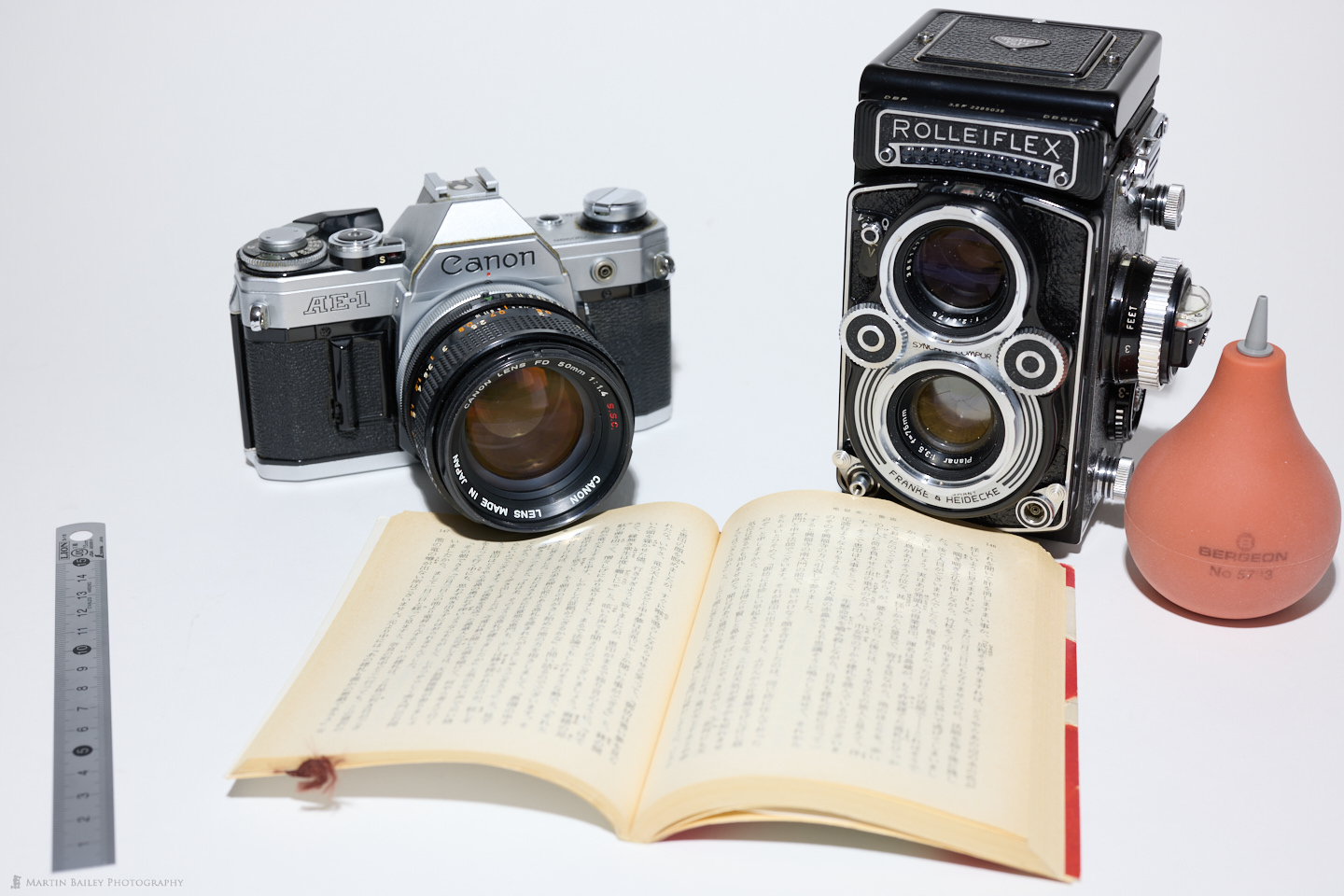
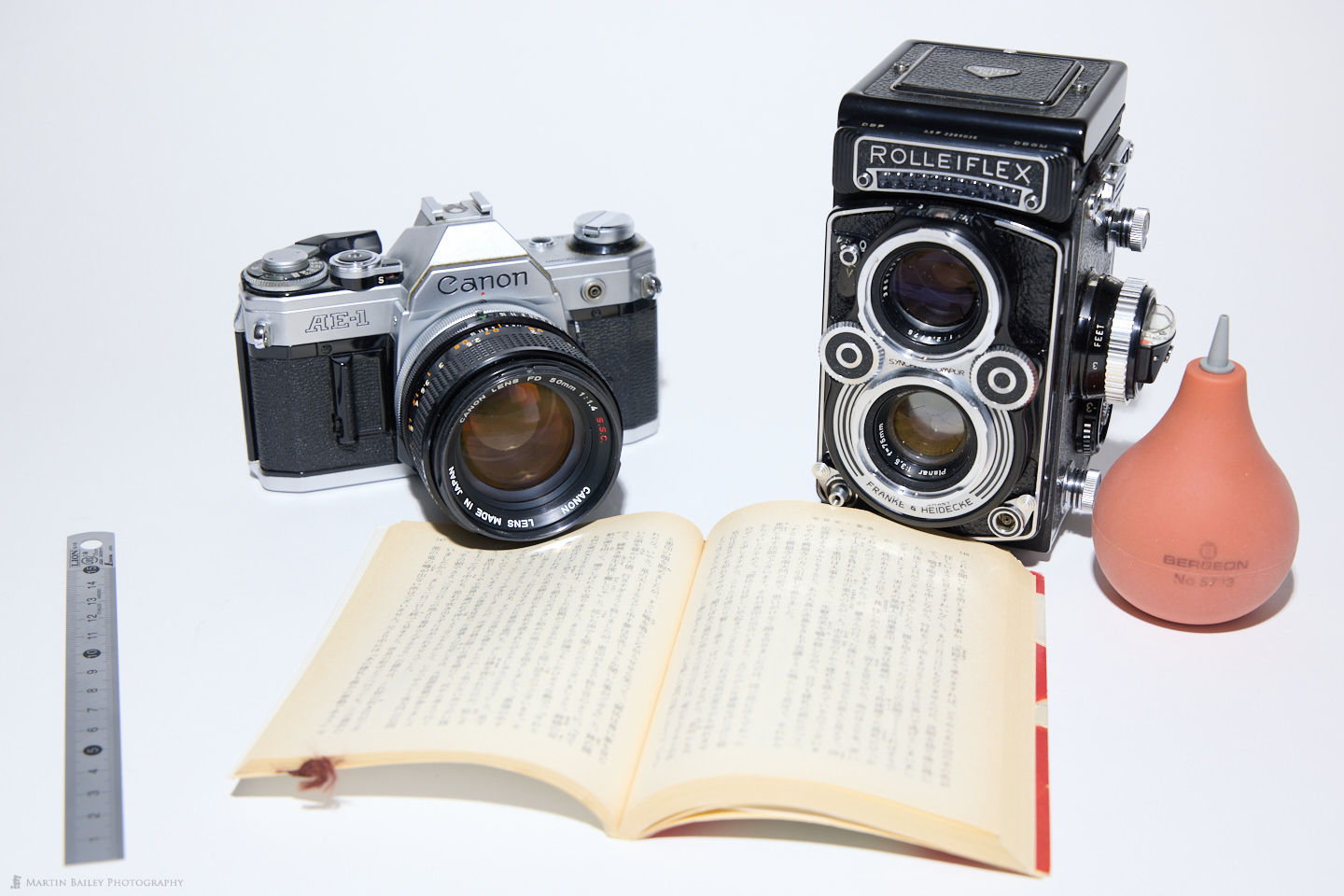
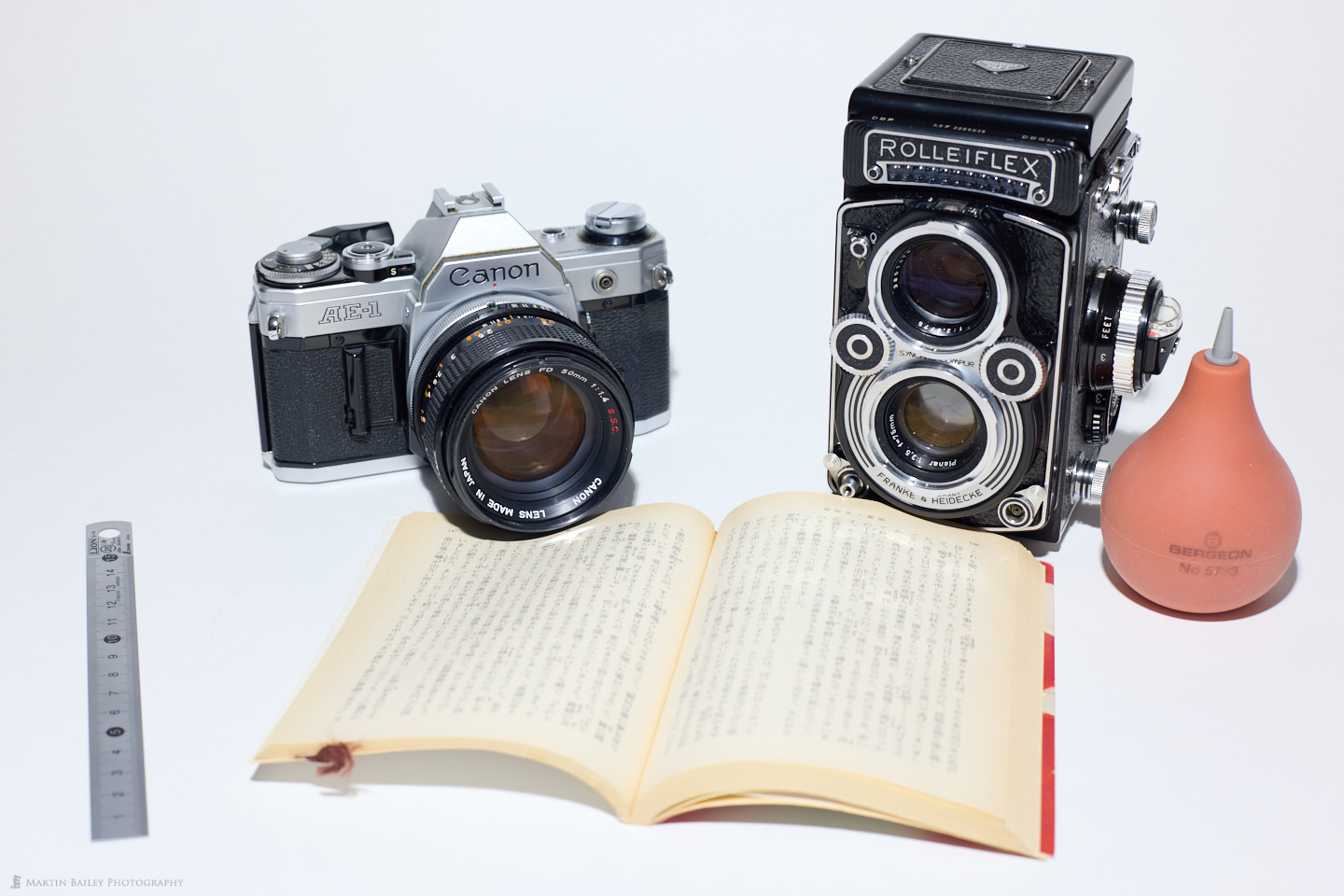
This first set is really just to enable you to literally see the bigger picture. Next, here are three crops of pretty much the same area of the same images at 100%. If you open these up in the lightbox viewer by clicking on them, you will be looking at 100% images assuming that your browser window is wide enough, and should be able to see the detail enough to evaluate the sharpness.
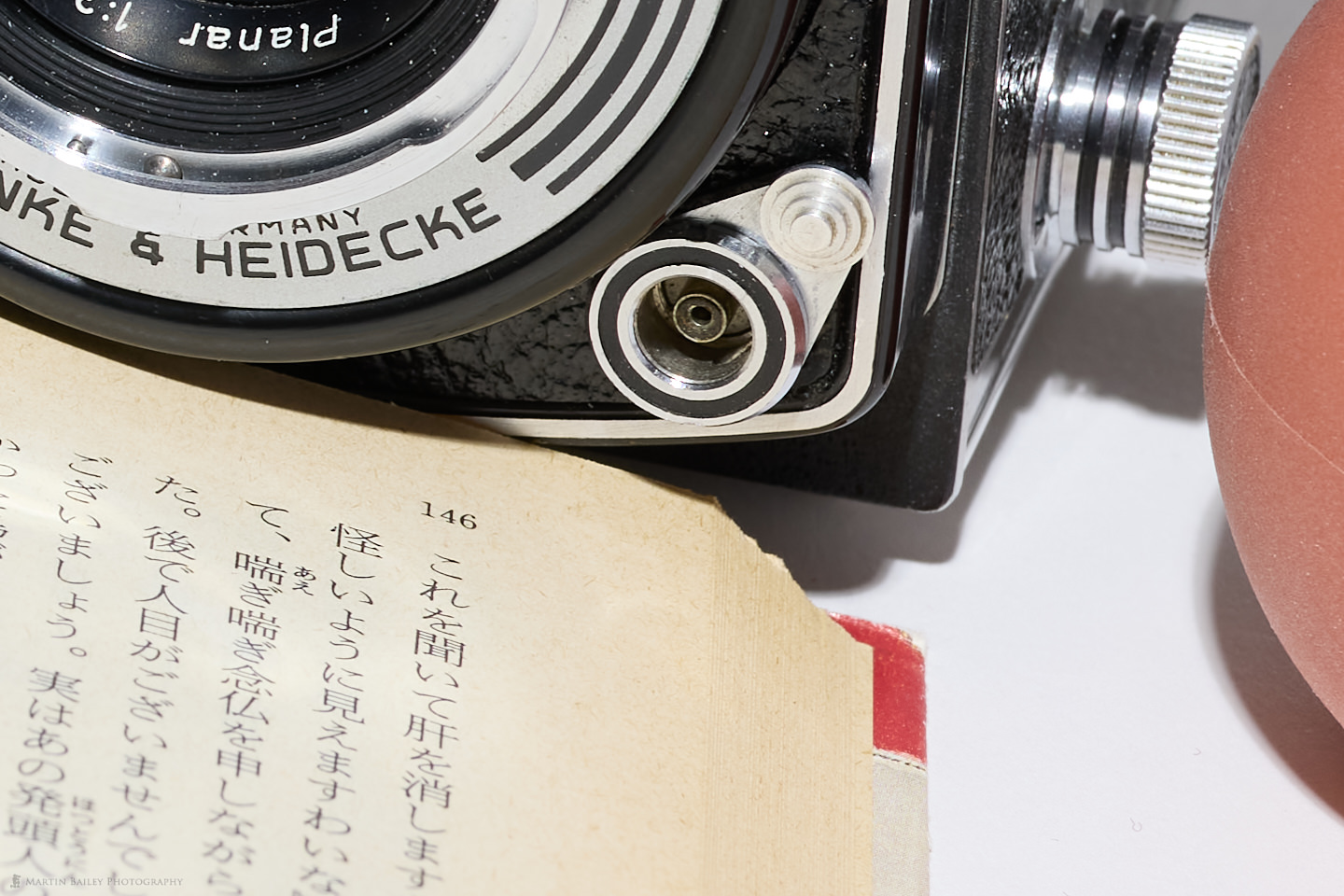
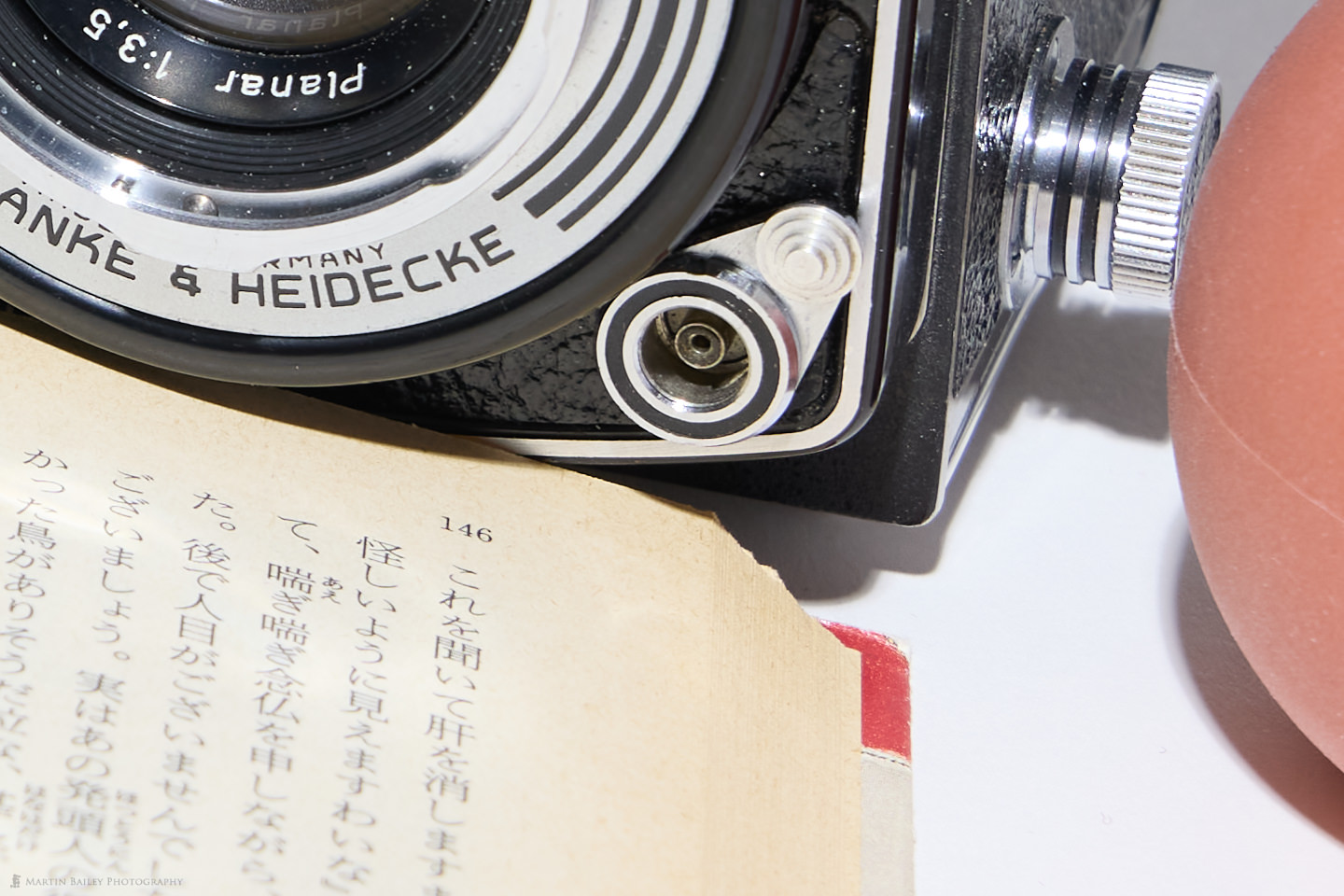
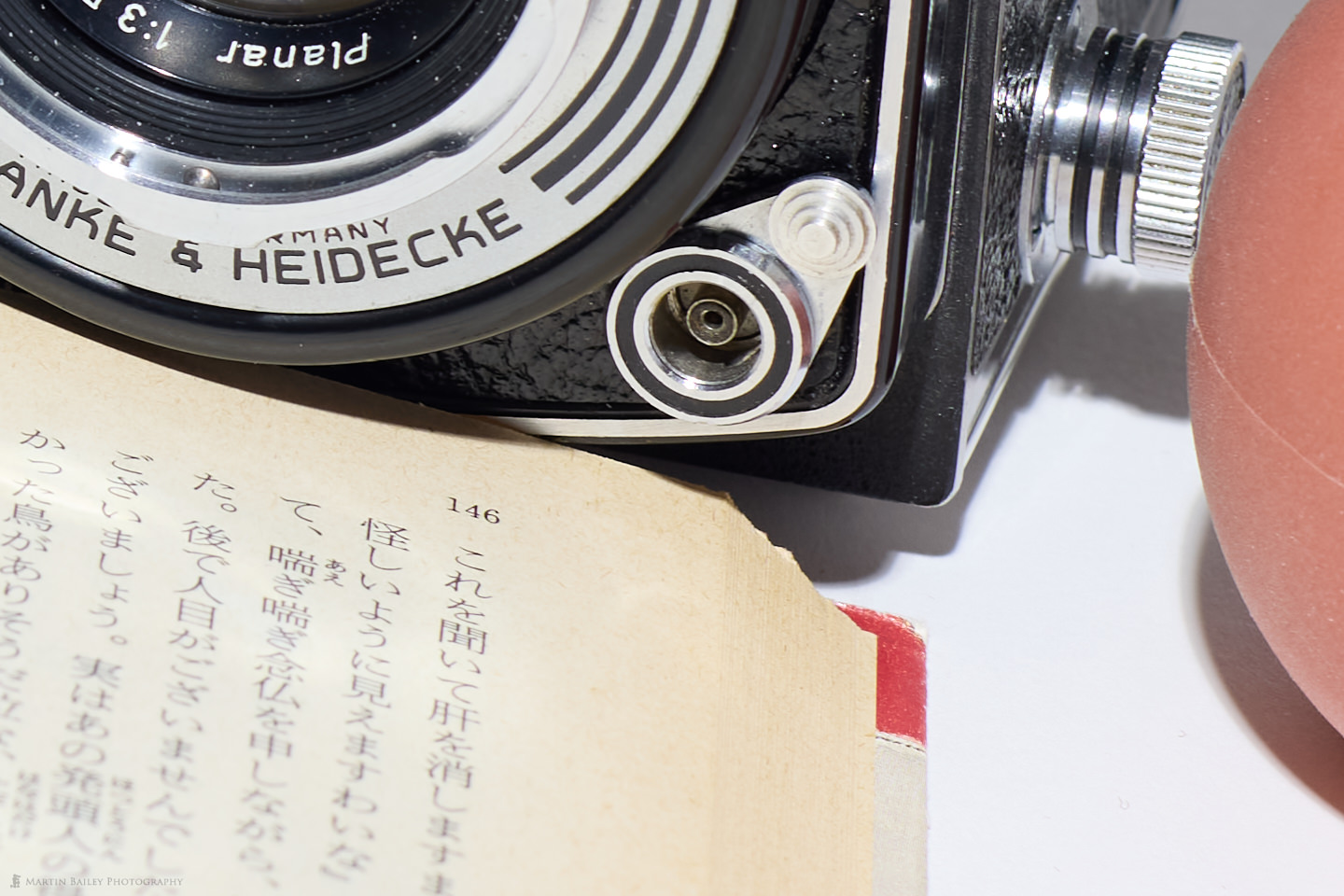
You’ll probably be able to see that although the characters on the page look slightly fainter in the 24-105mm lens, the sharpness, especially on the camera, are very similar with all three lenses. Sure, the 50mm RF lens is probably fractionally sharper than the other two, but is the difference great enough to warrant avoiding using a zoom lens altogether? Let’s keep looking to gain the information needed to really make a decision.
Here is another set of crops, from the same three images, this time from the bottom left corner, where I placed that steel rule. The rule is pretty much out of focus through the shallow-ish depth of field at this shooting distance at ƒ/8, but I wanted to share this to show that although there is really not a lot of distortion there is a little bit of color fringing on either side of the rule in the old 50mm and the 24-105mm lenses, but that is not visible in the RF 50mm prime, so it does have a slight advantage here too. In regular subjects, where you have texture and/or various colors in the frame, the fringing is more difficult to see, but it’s nice to know that it’s happening so that we can check and fix it if necessary when working on important projects.
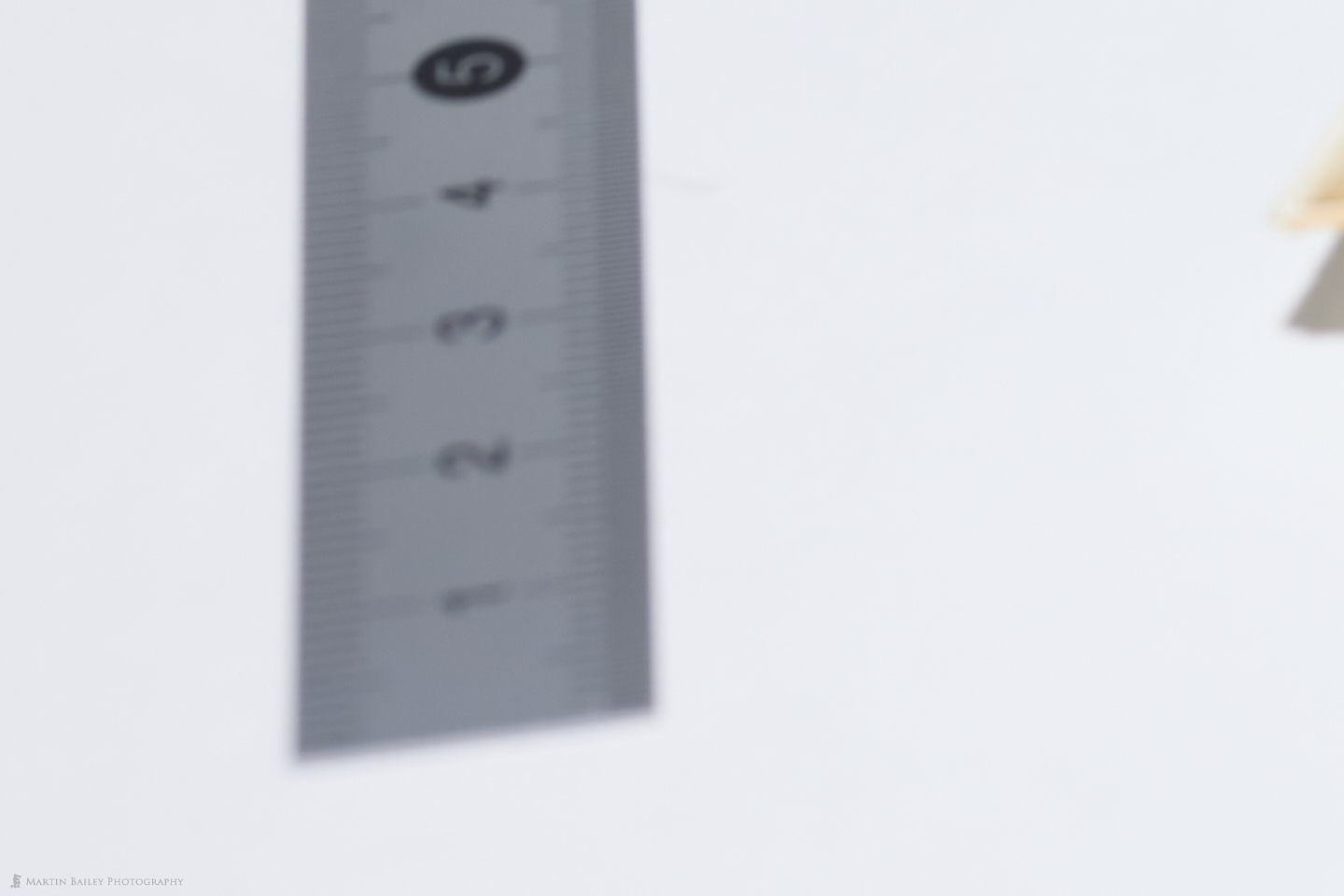
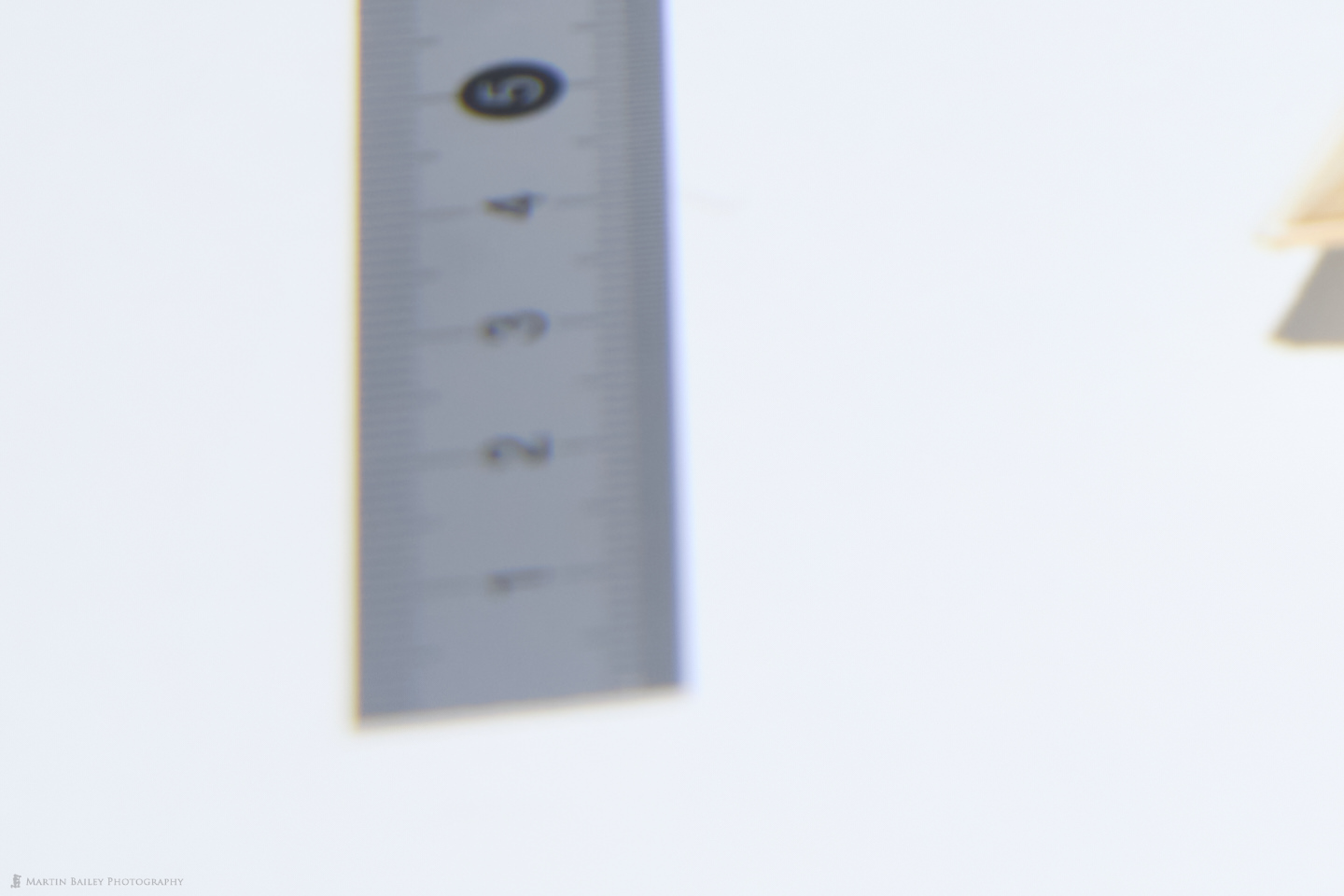

Now, I haven’t tested the wider focal lengths of my 24-105 in this session. We can, of course, expect image quality to drop slightly close to the extremes of the zoom, although the 24-105 doesn’t suffer much at the wide end, and is a little softer when zoomed all the way into 105mm, but it’s not a huge drop in quality. When I get some time I may well compare my 100mm macro lens, another prime lens, with the 100mm point on my 24-105mm and my 100-500mm lenses, but I already know from testing both of these zoom lenses and the 100mm macro lens for that matter, that they all perform admirably, so there really isn’t much of a need to compare them directly in this context.
And that brings me nicely to my final thoughts on this subject. As I said, I really wanted to gather the information required here to be able to show you that the difference is minor. Although there is a small increase in quality in the prime lens over the zoom lens for the majority of my shooting, I work with zoom lenses, and I’d like to finish with my thoughts on why that is, and why you also need to make your own decisions.
Personally, I am pretty much always going to choose the zoom lens for travel and landscape photography, because it is so much more versatile in the field. Sure, you can zoom with your feet, but there are limitations that we face such as shooting position restrictions, private land etc. that will often make it necessary to shoot from a certain distance. Yes, we can crop our images a little if we need to get closer but couldn’t physically do so, but I have 45 megapixels, and I want to use as many of those pixels as possible. This is my choice, and may not be so important for you. I prefer to be able to get my framing as close to perfect in the camera, to avoid cropping when possible.
With my own lenses, I just don’t think the drop in image quality is great enough for me to want to try to work with prime lenses. If you consider the number of lenses I’d need to even start to cover my current kit in primes, it soon becomes obvious that it just isn’t realistic, both financially and in my ability to actually carry the lenses around. I’m currently working with three RF lenses that provide every millimeter from 15 to 500mm. To cover the main focal lengths I’d need 14, 24, 35, 50, 85, and 100mm lenses, so six lenses to replace my first two. Then I’d need a number of really big white lenses to cover key focal lengths that I get with my 100-500mm. I’ve done the 600mm gig, and the 300mm ƒ/2.8. I loved my old 70-200mm ƒ/2.8 lenses too, but I am really enjoying being able to work from 15 to 500mm with three great RF lenses. It’s just so much easier to get around with this kit.
So, why do I own the RF 50mm prime? Well, for me, the main reason is the wider aperture and the shallower depth of field that it brings to my photography. If it wasn’t for the widest aperture of ƒ/1.2 I wouldn’t own the 50mm lens. When you see how good the image quality is from the EF 50mm ƒ/1.4 lens, you could also argue that there is very little difference in aperture size between the ƒ/1.4 and the ƒ/1.2, although the prices vary hugely, so saving money on the ƒ/1.4 version is definitely an option too. Every gear decision we make is a trade-off, and it doesn’t always have to be cut and dry, and this brings me to my final point.
Gear is our enabler. It is by no means the be-all and end-all of photography. We are the creativity behind the camera, but photography has and always will have a strong link to the gear that enables us to do it, and at the end of the day, some gear is just so nice to use that it can override the arguments about whether A is better than B, or C. The 50mm ƒ/1.2 L lens falls at least partly into that category. It’s a solid, and yes heavy lens, but it feels great to work with, and the wide aperture with creamy bokeh is an added bonus, as is the ultimately very good image quality.
And ultimately, the decision as to whether or not you shoot mainly with prime lenses or like me, mainly with zoom lenses, is also very much a personal choice. My aim today is not to persuade you in either direction. My main goal, as I said at the start of this post, is to suggest that you question the reasons behind your decisions, and don’t base your decisions on commonly whispered photography mantras. Are prime lenses always better than zooms? In some ways, yes, but the flexibility of zoom lenses is undeniable, and I believe that the zoom lenses we have now are so good that it really isn’t necessary to take a second mortgage to buy an arsenal of prime lenses for the difference in image quality alone.
If you want to shoot with very wide apertures, that’s another story. Typically zoom lenses have relatively small widest apertures, so this should probably be the trade-off that you consider more than anything, and not because of the light-gathering aspect so much now either. ISO performance is also so good now that you can whack your ISO up to get the shot rather than using a wide aperture if exposure is the only consideration. Having said all that though, I still take my 50mm ƒ/1.2 prime lens to Namibia when I go, because I want to use the shallow depth of field in some of the portrait work I do there. I carry that brick of a lens around for almost three weeks, for probably around an hour’s worth of photography, but I don’t mind that at all because the results are beautiful.
You make up your own mind about this, and have fun with your photography. And do some tests for yourself, to see how your lenses fare. If you are happy with the quality you are getting with zooms, you probably don’t need primes just to increase the quality. It’s the other reasons we’ve touched on that should drive your decisions. When people say that primes are better than zooms, they are correct, but if you are lucky enough to be able to buy some quality L lenses or similar in your own system if you don’t use Canon gear, then you’ll probably be just as happy with the results from zoom lenses. And if you are a staunch prime-lenser, you’ve made your decisions too, and I don’t want to try and change that. I would ask though, that when you try to talk zoomers into your world, don’t only talk about image quality. You already know that the decision is about so much more than that.
I’ll add some affiliate links to the gear mentioned today to the show notes. If you buy from our friends at B&H Photo, please use these links to help keep the wheels on the MBP Wagon.
Show Notes
Canon RF 24-105mm F4 L: https://mbp.ac/rf24-105
Canon RF 50mm F1.2L: https://mbp.ac/rf50
Canon EF 50mm F1.4: https://mbp.ac/ef50mm14
Canon EOS R5: https://mbp.ac/EOSR5
Subscribe in iTunes to get Podcasts delivered automatically to your computer.
Download this Podcast as an MP3 with Chapters.
Visit this page for help on how to view the images in MP3 files.

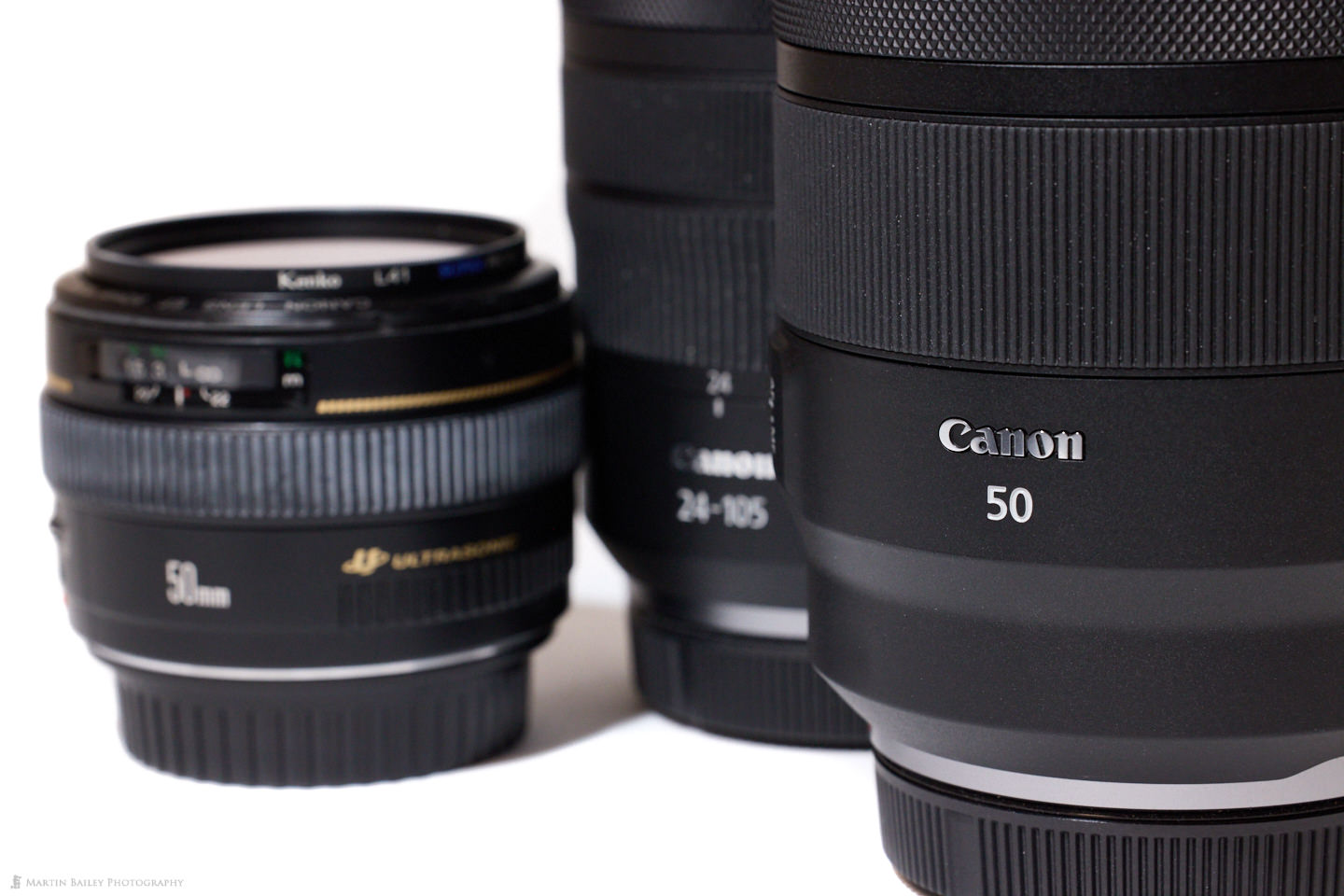


0 Comments